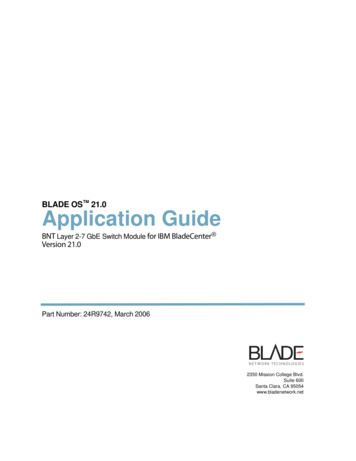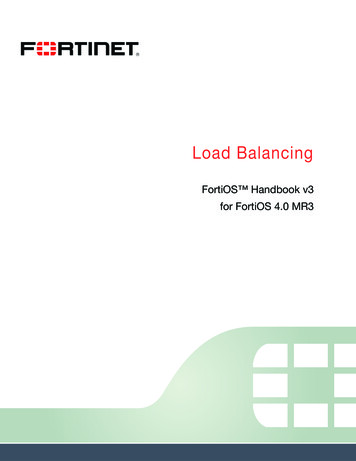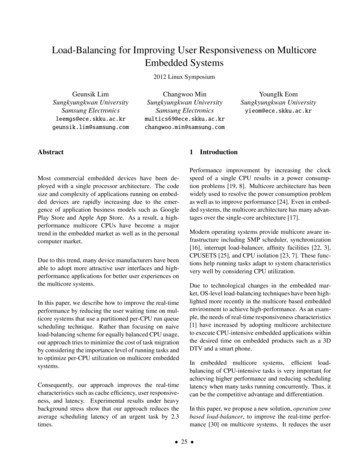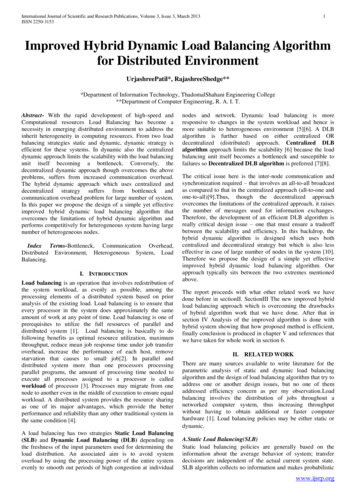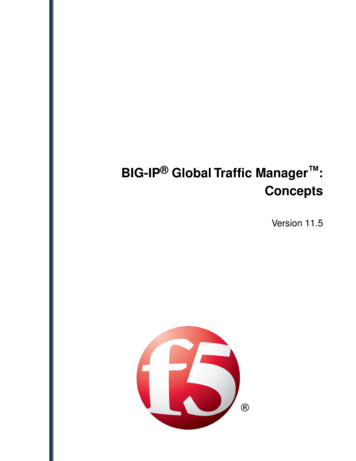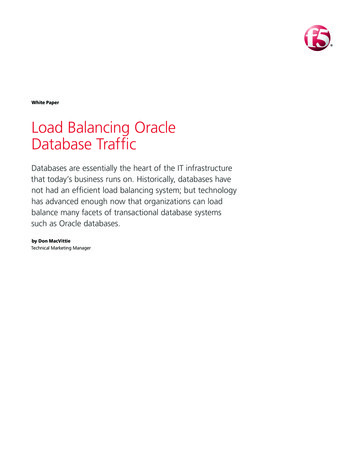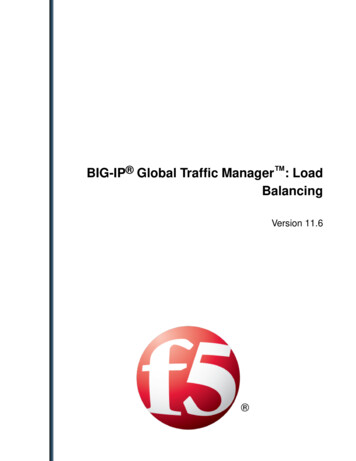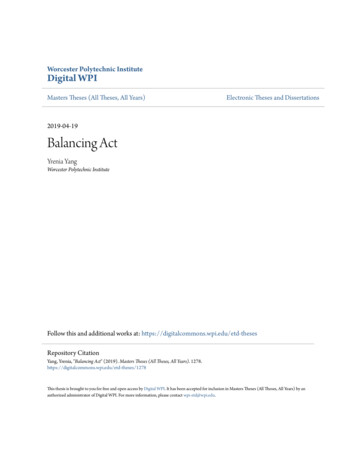
Transcription
Worcester Polytechnic InstituteDigital WPIMasters Theses (All Theses, All Years)Electronic Theses and Dissertations2019-04-19Balancing ActYrenia YangWorcester Polytechnic InstituteFollow this and additional works at: y CitationYang, Yrenia, "Balancing Act" (2019). Masters Theses (All Theses, All Years). 8This thesis is brought to you for free and open access by Digital WPI. It has been accepted for inclusion in Masters Theses (All Theses, All Years) by anauthorized administrator of Digital WPI. For more information, please contact wpi-etd@wpi.edu.
Balancing ActbyYrenia YangA ThesisSubmitted to the FacultyofWORCESTER POLYTECHNIC INSTITUTEin partial fulfillment of the requirements for theDegree of Master of ScienceinInteractive Media and Game DevelopmentApril 25th, 2019Approved:Lee Sheldon, Thesis AdvisorEd Gutierrez, ReaderGillian Smith, Reader
AbstractBalancing Act is a card matching game for 2 players that aims to inform playersabout basic money management principles. The purpose of the game is to educateplayers on different money management concepts in a fun and engaging manner. Thispaper will discuss the story of Balancing Act, the development of the game, and how thedesign of the game seeks to inform the player of its purpose. It will also include a postmortem that details the challenges of developing both a board and card version of thegame, the overall outcomes of the project, and future directions for the game.
AcknowledgementsI would like to express my appreciation and thanks to my advisor Professor LeeSheldon for his constant support and guidance through the course of my thesis project. Iwould also like to thank my committee members Professor Ed Gutierrez and ProfessorGillian Smith for their guidance, advice, and time in evaluating my work and providinginvaluable feedback.Additional thanks to fellow IMGD student Tianze Chen for helping me come up withideas for the initial design of the game board. I’d also like to thank the students of theWPI community for helping me playtest my game and providing suggestions onimproving it. Finally, I’d like to thank my mom Cynthia Lih, for always encouraging meand never letting me give up.
Table of Contents1.Introduction . 12.Background . 22.1 Financial Literacy in Young Adults . 22.2 Financial Literacy and Games . 32.3 Balancing Act’s Goal . 52.4 Target Audience . 53. Development Overview . 6Influences . 63.1 Pay Day . 63.2 Cashflow 101 . 73.3 Spent . 84.Inspiration. 85.Development of the Game . 95.1 Research . 105.2 First Iteration . 105.3Second Iteration . 175.3.2 Equipment . 205.2.3 Gameplay . 215.2.4 Game Flow . 236. Assessment . 266.1 Methods. 276.2 Results. 286.3 Problems in Evaluation . 377.Post Mortem . 387.1 What Went Wrong . 387.2 What Went Right . 398.Conclusion. 419. References . 43Appendix A: Production Schedule . 47Appendix B: List of Cards . 49Appendix C: Survey Questions. 55
Appendix D: IRB Approval Form . 57Appendix E: Pre-Test Survey Data . 58Appendix F: Post-Test Survey Data . 63
Table of FiguresFigure 1. Pay Day (Parker Brothers, 1975) . 6Figure 2. Cashflow 101 (Robert Kiyosaki, 1996). . 7Figure 3. SPENT (McKinney, 2011). . 8Figure 4. First Sketch of the Board . 12Figure 5. Orthographic View of the Board. . 12Figure 6. Second Sketch of the Board. 13Figure 7. Game Board with Residential Areas . 14Figure 8. Final Game Board . 15Figure 9. Event Card Categories . 16Figure 10. Track Card for Tokens. 20Figure 11. Question and Answer Cards . 21Figure 12. Pre-Test answers for question one . 29Figure 13. Post-Test Answers for Question 1 . 29Figure 14. Pre-Test Answer for Question 2 . 30Figure 15. Post-Test Answer for Question 2 . 31Figure 16. Pre-Test Answer for Question 3 . 31Figure 17. Post Test Answer for Question 3 . 32Figure 18. Pre-Test Answer for Question 5 . 33Figure 19. Post Test Answer for Question 5 . 33Figure 20. Pre-Test Answer for Question 7 . 34Figure 21. Post-Test Answer for Question 7 . 34Figure 22. Post Test Answers to Question 11 . 35
Figure 23. Post Test Answers to Question 12 . 36Figure 24. Histogram for Pre-Test Scores . 36Figure 25. Histogram for Post Test Scores . 37
1. IntroductionThe number of games that teach about personal finance and moneymanagement continue to be few and far between. Most students are not taughtfinancial literacy skills and the games designed to address this issue are oftenneither fun nor engaging (Greene 2018). Few schools also formally teach theseskills such as budgeting, balancing a checkbook, or differences between a stockand a bond, leaving families to fill the void in knowledge (Greene 2018).However, there is still the potential for students to learn financial lessons throughthe design of an interactive, educational game. In this project, I will discuss myattempts at developing a money management game and the resulting outcomesof this game.The goal of my game, Balancing Act, is to inform players of money managementtopics in a fun and engaging manner. For this project, I created 2 iterations of mygame. The first version of the game was a multiplayer life simulation board gamefor up to 4 players. As players progressed through the game, random eventswould occur that would force them to make difficult choices on whether to spendor save. In the second iteration of the game, I created a card matching game for2 players. In the game, players try to match question and answer cards togetherwhile learning topics about housing, insurance, credit and investments. Testingwas completed on the card game to determine the effectiveness of the game inteaching money management to players.Balancing Act is targeted towards players ranging from 18 to 22 years old, aswell as educators and students who are interested in learning more about1
economics or personal finance. It is hoped that by playing the game, players willgain a deeper understanding of basic finances in order to make better informeddecisions about money management.2. Background2.1 Financial Literacy in Young AdultsFinancial literacy is defined as “the ability to use knowledge and skills tomanage financial resources effectively for a lifetime of financial well-being”(Hung, Parker, & Yoong 2009). The ability to manage personal finances isincreasingly important in today’s world. For many young adults, their financialsituation is characterized by increasing levels of debt. This is a concern, giventhat many young adults may lack sufficient knowledge to successfully navigatethrough financial decisions (Lusardi 2010). A study at the University of Illinois atUrbana-Champaign on young adults found that nearly a third were “financiallyprecarious” because they had poor financial literacy, lacked money managementskills, and income stability. The study found that “the differentiator betweenpeople in financially precarious and at-risk groups from their peers was that theyexperienced less financial socialization, defined by the researchers as formal orinformal learning of financial concepts and money-management behaviors”(Forrest 2018). Knowledge of financial literacy has been shown to help increasethe likelihood of young adults from ages 25 to 34 in building savings and planningfor retirement, while decreasing the likelihood of using high cost borrowingmethods (de Bassa Scheresberg, 2010).2
2.2 Financial Literacy and GamesGames are not only developed and employed for entertainment purposesbut can also be incorporated as learning and training tools for a broad range ofdifferent areas (Hawlitschek & Joeckel, 2017). Research on the design andeffects of educational games suggests that they increase learners’ investment ofmental effort and learning outcome (Hawlitschek & Joeckel, 2017). One sucharea where educational games can be utilized is in financial education. In anever-evolving world, financial literacy is crucial for consumers, who must make awide range of financial decisions every day (Mitchell & Abusheva, 2016).However, challenges to financial literacy exist. These include the lack of adefined financial literacy structure, the perception of personal finance classes asboring, expensive, and not widely available, the lack of mandatory financialliteracy courses in universities and schools, and a limited number of teacherswho feel qualified to teach personal finance (Mitchell & Abusheva, 2016).However, there is the potential for video games to engage and build the financialliteracy of its players due to their popularity and immersive qualities (Maynard2012). While more research is needed, analysis of financial education gamessuggests that they can be successful at engaging players, building financialcapacity, and enabling them to take real world financial action (Maynard 2012).For example, “Bite Club” is a video game created by the Doorways to Dreams(D2D) Fund, a Boston based non-profit organization that works to improve thefinances of low- and middle-income consumers (The Economist, 2013). In “BiteClub,” players run a night club for vampires and collect money by serving3
customers the blood type the want, while storing away cash for retirement (TheEconomist, 2013). Other titles that have been released by D2D include “FarmBlitz” and “Celebrity Calamity.” In “Farm Blitz”, players are challenged to harvestcrops to pay off loans while fending off rabbits (which represent debt) (TheEconomist, 2013). In “Celebrity Calamity”, players act as a money manager for aHollywood starlet to keep her out of debt (The Economist, 2013). Evaluation ofFarm Blitz and Bite Club was conducted with user groups consisting of nine to 18participants (Maynard 2012). For “Beta” testing and preliminary testing, userscompleted a pre- and post-test of financial confidence questions and financialknowledge questions (Maynard 2012). Quantitative results showed that therewere overall positive gains in financial knowledge and self-confidence (Maynard2012).Another example of a financial education game called the “FinancialLiteracy Game,” was developed by a multidisciplinary team at Ohio Universityusing the Second Life platform (Liu 2011). In the game, the player takes on therole of an 18-year-old who has just graduated from high school (Liu 2011). As thegame progresses, the player must make different decisions, such as whether togo to college or find a job right away, whether to buy or lease a car, and when torent an apartment or move to a house (Liu 2011). The game also features anumber of quests that tests player’s knowledge of different financial situations.For example, a player may be presented with a car quest in which they go to acar dealership to buy a car. The car quest will then feature a video on a typicalsituation that a person might go through when trying to purchase a car (Liu4
2011). After viewing the video, the player will then be asked a series of multiplechoice questions that tests the player’s knowledge of that particular topic (Liu2011). Results of the study suggested that players felt the game helped improvetheir financial skills and provided enjoyment in learning about finance topics (Liu2011).2.3 Balancing Act’s GoalMoney management is defined as the “practice of handling one’s personalfinances” (“Money management”). Balancing Act’s aim is to inform players ofbasic money management concepts in a fun and engaging way. As many youngadults lack financial literacy and money management skills, there is an urgentneed for them to have a better understanding of how to handle personal financesas they transition into adulthood (Forrest 2018). In an article by the FinancialTimes, one in five young adults reported not being confident about managingtheir money, with nearly two-fifths saying that they did not know where to go toget help with their finances (Barrett 2018). This game will help them learn moreabout financial literacy and money management as they graduate from collegeand join the workforce and continue the transition to adulthood.2.4 Target AudienceI have selected an age group of 18-22 year old because my research hasshown that young adults have low levels of financial literacy. A study by theBrookings Institution found that “overall, undergraduate students in the U.S.demonstrated low levels of financial literacy” (Conzelmann & Lacy, 2018).5
Therefore, I would like to test the efficacy of my game as a viable platform forteaching money management to undergraduate students.3. Development OverviewInfluences3.1 Pay DayFigure 1. Pay Day (Parker Brothers, 1975) Source: URLPay Day is a board game originally made by the Parker Brothers that simulatesmoney management. The game board resembles a calendar month, with playersdeciding how many months the game should be played. Over the course of thegame, players will accumulate bills and expenses to pay, while also having theopportunity to make deals on property and earn money. At the end of eachmonth, players will pay off all their bills, collecting their monthly wages at the endof the month on pay day. The winner of the game is the player who has the mostmoney at the end of the last month of play. Like Pay Day, Balancing Act is similarin that it is also a money management game. However, the game differs in that it6
seeks to inform players of money management concepts related to housing,insurance, credit, and investing.3.2 Cashflow 101Figure 2. Cashflow 101 (Robert Kiyosaki, 1996). Source: URLCashflow 101 is a game developed by author Robert Kiyosaki to serve as a toolfor players to learn basic financial strategies and accounting principles. Financialstrategies are defined as “the practices an individual adopts to pursue theirfinancial objectives” (“Financial strategies”). Accounting principles are defined as“a collection of rules, procedures, and conventions that define acceptedaccounting practice” (“Accounting principles”). Investment techniques are definedas “actions or operations that are undertaken with the intention of generatingsome form of future income” (“Investment Methods”). The game teaches playershow to take charge of their personal finances, understand cash flow principlesand develop the ability to make investing and real estate decisions. The games issimilar to Balancing Act in that it seeks to teach its players personal financelessons. However, Balancing Act is different in that it seeks to inform playersabout money management concepts instead of investing techniques.7
3.3 SpentFigure 3. SPENT (McKinney, 2011). Source: URLSpent is an online game about surviving poverty and homelessness. It wasdeveloped by the ad agency McKinney for the Urban Ministries of Durham tohelp them tap into the power of social media and help them reach a new group ofgivers and volunteers (Northern 2011). Throughout the game, players make aseries of decisions which impacts their income and affects different areas of theirlife such as health, level of education, and ability to provide for their familymembers. The game ends when players run out of money before the end of themonth or make it through with money left over. Like Spent, players in BalancingAct must make decisions according to different scenarios that are presented tothem. However, Balancing Act differs in that it is about money management, notpoverty.4. InspirationBalancing Act is a card matching game for 2 players that aims to informthem of money management principles related to housing, insurance, credit, andinvestments. The main idea for creating this game came from a game proposalthat I had previously worked on. In my Game Design Studio class that I took withProfessor Lee Sheldon, I pitched an idea for a life simulation game dealing with8
poverty that the class could make as a group. My idea for that game was to createa single player game in Unity that would simulate the conditions of living in povertyand the challenges associated with it. Players would be immersed in a virtual worldwhere they would be given a limited amount of money and resources and mustdecide how to spend their money over a specified amount of time. While my gameidea was not selected to be made, I wanted to expand on this idea and see if Icould make a version of this game myself. I started to brain-storm ideas on how tocreate my game and thought about ways that I could improve it from my originalproposal. After deliberating for several weeks on direction on I wanted to take mygame, I finally settled on the idea of money management. My decision to do thiscame partly from my own personal experiences- my dad’s passing last year in2018 shocked me into realizing that I did not have a good idea of what was goingon with my family’s finances and how to manage them. My talks with some friendsfrom college also led me to feel that it would have been helpful if we had learnedmore about personal finances earlier in our lives and paid more attention to it.Therefore, I thought it would be both helpful and educational if I changed my lifesimulation game to be geared more towards money management so that playerscould learn something from it while also having fun.5. Development of the GameThroughout the process of developing the game, I made 2 iterations of myproject. The first game was a multiplayer life simulation board game for 4 players.The second game that was produced in response to feedback from the first gamewas a card matching game for 2 players.9
5.1 ResearchThis game required me to delve into research into the principles of moneymanagement. To do this I utilized books such as “Why Didn’t They Teach MeThis In School: 99 Principles of Money Management” by Cary Siegel and Focuson Personal Finance by Jack Kapoor. Siegel’s book consists of 99 personalmoney management principles that is targeted towards both high school andcollege students. Kapoor’s book is a 14-chapter book that covers critical topicsfrom personal finance courses, such as budgeting, taxes, credit, insurance, andinvesting.5.2 First IterationIn my first iteration of the game, I created a multiplayer life simulation game thatinvolved money management. The goal of the game was to have players balancetheir incomes and expenses while also looking after their health, happiness, andrelationship levels. At the beginning of the game, players received 2000 in playmoney and chose a job and house to live in. Players then rolled a die and madea money management decision based on cards they drew that featured real lifeissues. Each player also received a set of happiness, health and relationshiptokens, and would gain or lose their tokens depending on whether they chose tospend of save their money in the game. The first player to reach the maximumlevel of health, happiness, and energy tokens or have the most amount of cashremaining when all the cards run out wins the game.5.2.1 Equipment10
The game pieces in Balancing Act include:TokensHappinessHealthRelationshipsGame BoardThe design of this game board proved to be a significant challenge. As amultiplayer game with up to 4 people playing, this presented a design challengeas the view of the game board would look correct to only one person anddistorted to the other 3 people playing the game. My first attempt at creating theboard was to make a 3D version of a city, where players could move frombuilding to building depending on what cards they drew and where the cardsdirected them to go.11
Figure 4. First Sketch of the BoardI then thought about designing the board from an orthographic perspective, sothat the view would be the same for all players, however it would be hard todistinguish which building was which.Figure 5. Orthographic View of the Board. Credit: Tianze Chen12
I then tried to see if I could incorporate both residential areas and buildings on all4 sides of the board. I put inner city housing on the innermost center of theboard, with smaller houses and bigger houses on the outer edge. I then put thebuildings on all 4 corners for players to travel to. However, the problem with thisdesign was that the board became too crowded, leaving little room for space inbetween buildings. In addition, the buildings would look upside down to someplayers depending on where they were sitting.Figure 6. Second Sketch of the BoardI deliberated for a long time on how to design the board so that players on all 4sides could view the board correctly from each person’s perspective. The finalsolution that I came up with was to design the board in an ‘X’ shape, and to puteach of the residential houses inside those areas. I removed the buildings fromthe board due to space constraints and because their functionality ended up notbeing used in the game. I also included the addition of a token grid containing13
happiness, health, and relationship categories where the player would either gainor lose these tokens depending on how they fared during the game.Figure 7. Game Board with Residential AreasThe final game board featured a residential area with different types of housingthat the player could choose from. I added an arrow that went from red to greenwhich would reflect the players’ health, happiness and health levels in the game.The outer edge of the board contained a chart in which players could move theirdifferent tokens across the spaces on the board to monitor their progress in thegame.14
Figure 8. Final Game BoardEvent CardsThere were 6 categories of event cards, which included Bad Luck, Good Luck,Health, Money, Work, and Relationships. To select a card, players rolled acustom die with the following 6 symbols and select the top card of a stackcorresponding to the symbol on the die. - Good Luck - Bad Luck-Money-Health- Work- Relationships15
Figure 9. Event Card CategoriesPlayers would then follow the directions on the card and proceed to either spendor save their money according to the scenarios on the card.5.2.2 FeedbackA playthrough of my game was conducted over spring break with 4 professorsfrom the IMGD department. The feedback that I received from the playthrough ofthe game indicated that the game’s mechanics and gameplay needed to beimproved. First, the game was taking players too long to play. There were alsotoo many things to keep track of, such as when players should receive salaries,when they should pay rent, as well as having to keep track of the amount of16
money in their hand. Second, using the dice as a core mechanic of the game tohave players decide which cards to draw proved to be problematic. This wasbecause the random nature of the die prevented players from seeing the samecards as well as prevented them from being able to make any strategic moves inthe game. In addition, many of the cards did not teach money managementlessons to the player. Based on this feedback, I decided to make a seconditeration of this game to resolve these problems.5.3Second IterationFor the second iteration of my game, I decided to create a card matching gameabout money management for 2 players. I focused the contents of my cardsaround the topics of Housing, Insurance, Credit, and Investments. I created 20question cards with scenarios and decisions and 20 answer cards for eachcategory, with each card featuring a different money management principle. Thefollowing table illustrates examples of topics in the game, their teachingmechanism, and evaluation questions.TopicRenting vs. owningUnderstand thedifferences betweenrenting vs owning and thebenefits of each.Game MechanicThere are several differentcards that discuss thedifferences betweenrenting vs. owning. Forexample:1. You would like tocompletely redesign yourbathroom.17Evaluation Question1. What are the benefits ofowning? (Check all thatapply)oooPersonalizing yourliving spaceLess costly repairsMobility
Benefits of renting: Less costly repairsEasier relocation ifmoving in thefutureBenefits of owning: Ability topersonalize yourliving spaceAbility to buildpersonal wealthBeing able todeduct mortgageinterest fromtaxable incomeInsuranceUnderstand the purposeof insurance and thebenefits of renters andhomeowners insurance.oDo you:A) Try remodelingB) Leave it alone.Answer: B) You are notable to update orpersonalize your livingspace in an apartment.oDeducting mortgageinterest from taxableincomeBuilding wealth2. If you want to personalizeyour living space, it is easierto do
attempts at developing a money management game and the resulting outcomes of this game. The goal of my game, Balancing Act, is to inform players of money management topics in a fun and engaging manner. For this project, I created 2 iterations of my game. The first version of the game was a multiplayer life simulation board game for up to 4 players.
